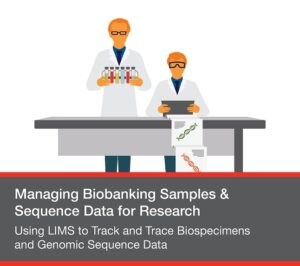Using LIMS to Track and Trace Biospecimens and Genomic Sequence Data
 Biobanking is an intriguing portion of the world of research. For some, operating a biobank is an active project, involving partnerships and customers. While for others, biobanking is a portion of a laboratory workflow. Still others use it as the “attic” of their organization—going to retrieve a sample if and when they think there is a need for it.
Biobanking is an intriguing portion of the world of research. For some, operating a biobank is an active project, involving partnerships and customers. While for others, biobanking is a portion of a laboratory workflow. Still others use it as the “attic” of their organization—going to retrieve a sample if and when they think there is a need for it.
For biobanking to work effectively, the tracking and tracing of samples must be precise. This leads to the use of automated/robotics systems or, at the very least, a Laboratory Information Management System (LIMS) to ensure the metadata associated with each and every sample is correct. By using an informatics system, users can see the occurrence of errors decrease and workflow efficiency increase.
We work with a variety of customers who use biobanking for various, yet similar reasons. As a Customer Success Manager (CSM), I see a multitude of workflow configurations, but usually biobanking is used to keep track of biological data. For some customers, the samples being biobanked need to be accessed or rotated regularly, while for others the biobanking is more for IP security.
Biobanking in R&D
One of our customers is a research center that studies global emerging diseases, such as SARS and West Nile virus. For this client, Thermo Scientific™ Core LIMS™ software manages biological data as samples are registered, and then keeps track of the genetic sequencing data coming out from these samples.
Multiple data types are captured by the LIMS in this implementation, including timestamps sensitive to the day of the week, integers sensitive to specific criteria, image thumbnails, and more. All of this metadata is used to build a comprehensive and searchable registration process.
In certain cases, the user supplies the sample barcode, in other cases the LIMS assigns a customizable sequential barcode and name. This versatility gave the customer flexibility when it came to integrating the LIMS into its workflows. All lots in the system are tracked and passed into several sequencing experiments. Each experiment serves as an event where data about the experiment is stored, but the sequencing data is referenced to another location using a URI data-type.
All of the information collected within the LIMS tells a complete backstory of the sample, allowing a researcher to know all important data points and actions in the future. This configuration enabled the integration of a bioinformatics repository to complement the biobanking aspects of the laboratory, enabling the user to perform customized queries to access all their data.
A Laboratory Platform for Biobanking
A lab informatics system needs to track and manage information around all biobanked samples in the system. Thermo Fisher™ Platform for Science™ software was designed to easily allow for variety in how biobanking is used in a laboratory workflow. Laboratories can use the modular applications available on the Thermo Fisher™ Platform for Science™ Marketplace solution to build a Biobanking Solution to fit their needs.
Jose Murga is a CSM residing in NYC. He graduated from Queens College (’98) with a Bachelor’s Degree in Biology and earned a Master’s Degree from New York Medical College. He has been a research scientist at Progenics Pharmaceuticals and contributed to the publication of research articles in various drug discovery programs including HIV (the virus that causes AIDS), HCV (Hepatitis C Virus), PI3K inhibitors in oncology pathways and antibody-drug conjugates specific to Prostate Cancer.
Leave a Reply